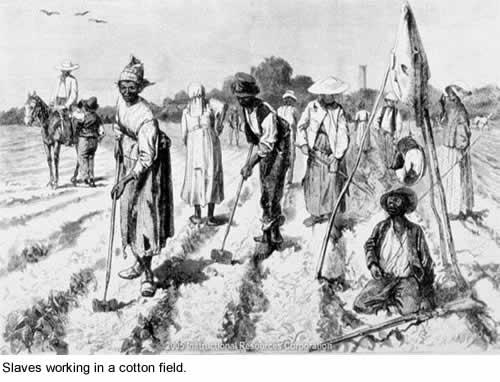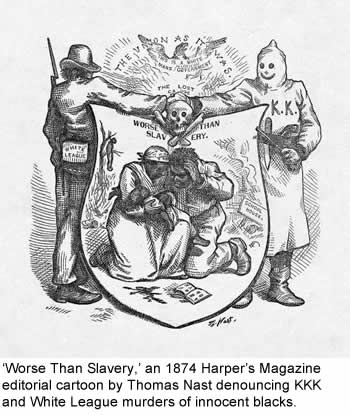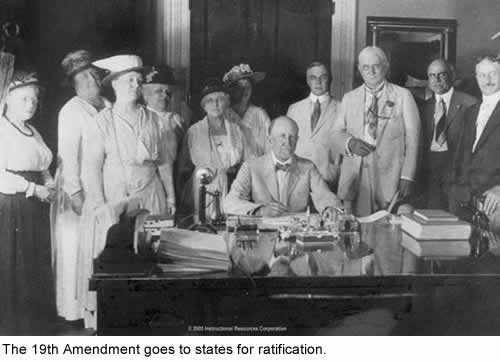Learn
To access the materials on Discovery Education website, you will need to log in. View the login instructions.
Expansion of Suffrage
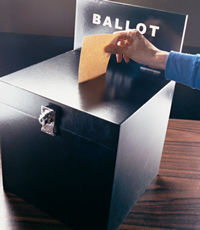
In the early years of United States history, more people were able to vote than were commonly eligible to vote in European democracies of the day. However, the idea of the Founding Fathers that "all men are created equal" seemed to apply only to white males who owned property early in our history.
Expansion of Suffrage to 1828
By 1828, the requirement of property ownership and church membership were removed so that universal white manhood suffrage prevailed. Still, not all American citizens were eligible to vote. African-Americans and women were excluded from voting for many years.
While the Framers neglected to treat African-Americans and women as equal citizens, the amendment process they established has allowed our Constitution to change in order to right the wrongs of our past.
Watch Amending the Constitution (1:22) to learn more about the amendments that expanded voting rights in our nation.
Amendments for Former Slaves
Following the Civil War, three amendments were added to the Constitution in an effort to give former slaves rights as Americans.
The Thirteenth Amendment (1865) freed all slaves by outlawing slavery or involuntary servitude.
The Fourteenth Amendment (1868) extended citizenship to blacks and prohibited states from denying the rights and privileges of citizenship to any person born or naturalized in the United States.
The Fifteenth Amendment (1870) provided that the right to vote shall not be denied on account of race, color, or previous servitude.
Image credit: Slaves Working in a Cotton Field IRC, 2005. [Image]. Discovery Education.
Black Codes
After Congress passed the Thirteenth Amendment and the Civil Rights Act of 1866, southern legislatures passed laws known as black codes to restrict African-Americans from gaining civil and social rights because they feared black political influence.
Black codes used vagrancy laws to pressure freedmen to work for the white landowners under a labor contract. African-American vagrants were subject to being arrested and sentenced to hard labor to pay their fines. The wealthy southern landowners approved of the codes because they helped ensure a work force in African-Americans.
Even though the black codes were restrictive for freedmen or former slaves, the children received an education thanks to the Freedmen's Bureau and local churches.
When the Republican Congress took control of Reconstruction, they forced the southerners to repeal many of the black codes. However, when Reconstruction ended, many of these laws reappeared in another form called Jim Crow laws. There were no guarantees for the freed slaves without a constitutional amendment.
Fifteenth Amendment

While the Fourteenth Amendment was an attempt to give African-Americans the rights of citizenship and to end the black codes, African-Americans still had no voice in the political process. They lacked the right to vote, which is the most important tool for a citizen.
Congress accepted the first and most moderate version of the Fifteenth Amendment, which prevented states from denying the vote to anyone because of their race, color, or previous experience of being a slave.
Watch 13th, 14th, and 15th Amendments Establish Civil Rights for All (2:24) to hear the words of these historical amendments.
When eleven more states were needed to ratify the amendment, Congress required southern states not yet admitted to the Union to accept both the 14th and 15th Amendments.
For over a decade during the 1870s, adult African-American men were generally allowed to vote.
Read "Passage of the Fifteenth Amendment" to learn more about how this amendment addressed the inadequacies of the previous two.
Image credit: "The First Vote," an 1867 Wood Engraving IRC, 2005. [Image]. Discovery Education.
Suffrage for Women
Women's suffrage leaders had hoped the right to vote granted to African-Americans by the Fifteenth Amendment would extend to women as well. However, suffrage for women would continue to be a long and hard-fought battle. Suffrage supporters rallied under national organizations like NAWSA to achieve the right to vote after smaller statewide victories in Wyoming, Utah, New York, and several other states.
Read "Women's Suffrage at Last" to learn more about the fight to gain the right to vote for women.
Nineteenth Amendment
It took years of meetings, parades, and even hunger strikes before women finally got the right to vote. By the time the 19th Amendment was passed in 1920, women had fought for over 100 years to achieve the right to vote.
The Nineteenth Amendment (1920) gave women the right to vote by providing that the right of citizens to vote shall not be denied on account of sex.
Watch Women's Suffrage Movement: Gaining Equality for Women (3:17) to learn more about the fight for suffrage.
Image credit: 19th Amendment Goes to States for Ratification IRC, 2005. [Image]. Discovery Education.
Changes in Voting Age
As the attention of the nation turned to protests over the war in Vietnam, concerns over the right to vote for 18-21 year olds moved to the forefront of the nation's attention. In 1971, Congress passed the Twenty-Sixth Amendment lowering the voting age to 18 years of age.
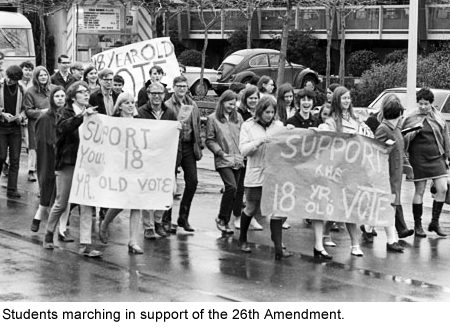
Watch Voting Behavior Differs between Age & Class (6:47) to learn more about how Americans vote according to age, class, gender, and race.
Visit Rock the Vote to learn more about the youth vote and how you can register to vote.
Image credit: http://origin.democrats.org/40th-anniversary-of-the-26th-amendment.
